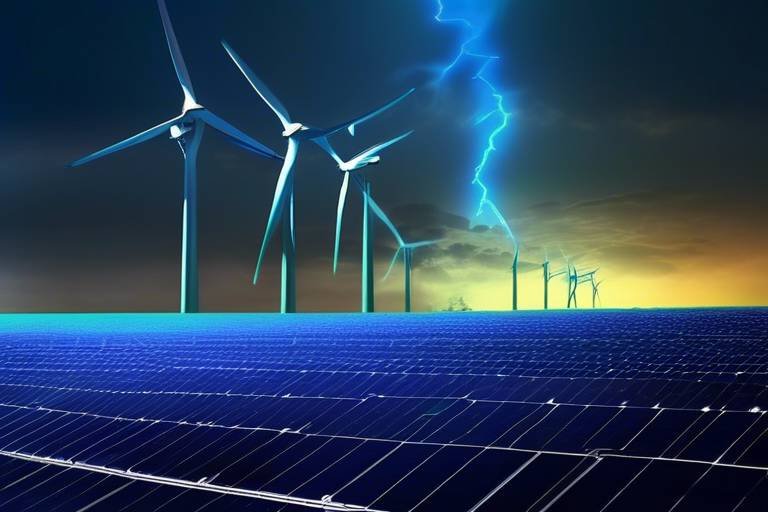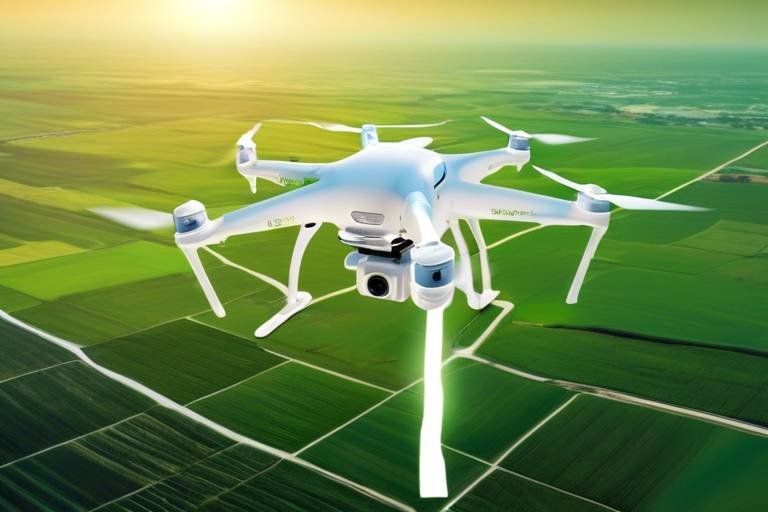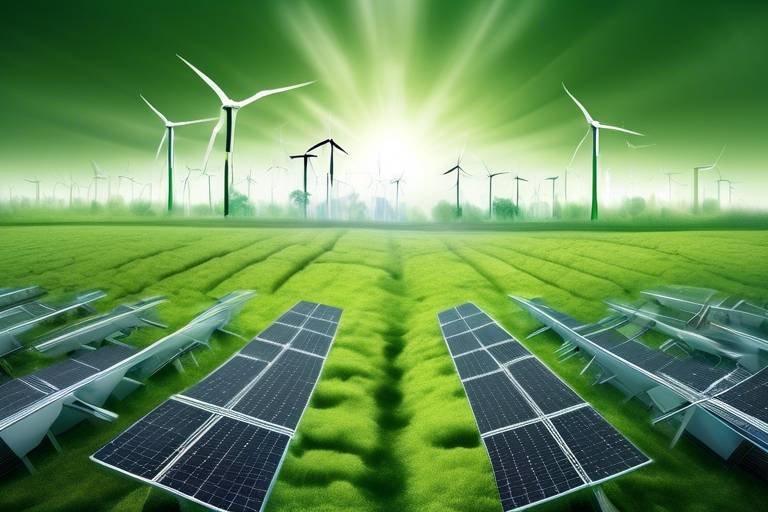Fitness to Power - How Kinetic Energy Contributes to Eco-Friendly Alternatives
In a world increasingly concerned with sustainability and environmental impact, the concept of kinetic energy emerges as a beacon of hope. Imagine if every step you took, every pedal you pushed, and every movement you made could contribute to a greener planet. Sounds like a dream? Well, it’s becoming a reality! This article explores how kinetic energy is not just a scientific principle but a powerful ally in creating eco-friendly alternatives that enhance our fitness and health. From innovative technologies to practical applications in our daily lives, the potential of harnessing kinetic energy is both exciting and transformative.
So, what exactly is kinetic energy? In simple terms, it's the energy that an object possesses due to its motion. The faster something moves, the more kinetic energy it has. This principle is crucial for understanding how we can harness this energy for sustainable solutions. Think of it like a roller coaster: as the coaster climbs higher, it stores potential energy, but as it descends, that energy transforms into kinetic energy, propelling it forward. In the context of sustainability, this transformation can be harnessed to power our homes, cities, and even our fitness routines. By tapping into kinetic energy, we can reduce our reliance on fossil fuels and promote a cleaner, greener future.
Now that we've got the basics down, let’s dive into some of the cutting-edge technologies that are making waves in the world of kinetic energy. These innovations are not just theoretical; they are actively being implemented in various sectors to promote environmental sustainability. From piezoelectric devices that generate energy from everyday movements to regenerative braking systems that capture energy from vehicles, the applications are as diverse as they are impactful.
One of the most fascinating developments in kinetic energy technology is piezoelectric energy harvesting. This involves materials that generate electricity when subjected to mechanical stress. Imagine walking on a piezoelectric floor that converts your footsteps into energy! This technology is being integrated into various environments, such as roads, where the pressure from vehicles can generate power, or even in footwear designed to harness energy from our daily movements. This not only promotes sustainability but also offers a unique way to power our devices without relying on traditional energy sources.
Smart cities are at the forefront of integrating piezoelectric energy harvesting into their infrastructure. By embedding piezoelectric materials into sidewalks and roads, cities can capture energy from the bustling activity of pedestrians and vehicles. This energy can then be used to power streetlights, public transport systems, and other urban amenities, significantly reducing the carbon footprint of urban areas. It’s a win-win situation: as we move about our daily lives, we contribute to a cleaner environment!
On a more personal level, wearable technology is revolutionizing how we think about fitness and sustainability. Devices that harvest kinetic energy from our movements—like running, cycling, or even walking—are becoming increasingly popular. These wearables not only track our fitness levels but also convert our physical activity into usable energy to charge our phones or other gadgets. It’s like having a personal energy generator that empowers us to stay fit while contributing to a sustainable future!
Another remarkable application of kinetic energy is seen in regenerative braking systems. These systems are designed to capture the kinetic energy produced when a vehicle slows down. Instead of wasting that energy as heat, regenerative braking converts it back into usable power, which can then be stored in batteries for later use. This technology is particularly significant for electric vehicles and public transportation systems, where efficiency is key. By utilizing kinetic energy in this way, we can enhance the performance of our transport systems while reducing reliance on non-renewable energy sources.
Beyond technology, kinetic energy plays a pivotal role in promoting active lifestyles. As we strive to maintain our health and fitness, we can also embrace eco-friendly practices that utilize our movements to generate energy. This not only benefits our bodies but also supports a healthier planet.
Imagine working out in a gym where every push, pull, and pedal contributes to energy generation. Eco-friendly gyms are incorporating equipment that harnesses kinetic energy from workouts. Treadmills, stationary bikes, and other machines are being designed to convert the energy exerted during exercise into electricity. This innovative approach not only enhances the user experience but also contributes to sustainability by reducing the gym's overall energy consumption.
Outdoor activities like cycling and running can also play a role in energy generation. Some initiatives encourage fitness enthusiasts to participate in programs that convert their physical activity into energy credits. For instance, bike-sharing programs equipped with kinetic energy converters allow cyclists to generate power while they ride. It’s a fantastic way to promote fitness while giving back to the community and the environment!
- What is kinetic energy? Kinetic energy is the energy that an object possesses due to its motion. The faster it moves, the more energy it has.
- How can kinetic energy be harnessed for sustainability? Kinetic energy can be captured through technologies like piezoelectric devices and regenerative braking systems, which convert movement into usable power.
- What are eco-friendly gyms? Eco-friendly gyms use equipment that generates energy from workouts, helping to reduce their carbon footprint while enhancing the fitness experience.
- Can outdoor activities contribute to energy generation? Yes! Activities like cycling and running can be part of initiatives that convert physical activity into energy credits or power.

The Basics of Kinetic Energy
Understanding kinetic energy is crucial for grasping its applications in eco-friendly technologies. Kinetic energy is the energy that an object possesses due to its motion. Imagine a rolling ball; the faster it rolls, the more kinetic energy it has. This concept is not just a physics lesson; it plays a significant role in our quest for sustainable energy solutions. As we become more aware of our environmental impact, harnessing kinetic energy becomes an exciting prospect for creating cleaner, greener alternatives to traditional energy sources.
At its core, kinetic energy can be described with the formula: E_k 1/2 mv², where E_k is kinetic energy, m is mass, and v is velocity. This mathematical relationship shows that even a small increase in speed can lead to a substantial increase in energy. So, how do we tap into this energy source? The answer lies in innovative technologies designed to capture and convert kinetic energy into usable power, which can significantly contribute to sustainability efforts.
Kinetic energy is not just a theoretical concept; it manifests in numerous ways in our daily lives. For instance, when we drive a car, the kinetic energy generated can be harnessed through various systems to improve fuel efficiency and reduce emissions. Similarly, when we walk or run, our movements create kinetic energy that can be captured and converted into electricity. This potential makes kinetic energy a valuable resource in our transition towards a more sustainable future.
One of the most promising aspects of kinetic energy is its versatility. It can be utilized in a variety of applications, from powering small devices to contributing to large-scale energy solutions. Consider the following examples of how kinetic energy is being integrated into our lives:
- Transportation: Vehicles equipped with regenerative braking systems can convert kinetic energy generated during braking back into electrical energy, improving overall efficiency.
- Wearable Technology: Devices that harness kinetic energy from human movement are becoming more popular, allowing individuals to generate power simply by being active.
- Infrastructure: Roads embedded with piezoelectric materials can capture energy from vehicles passing over them, contributing to urban energy needs.
As we explore the innovations and technologies that harness kinetic energy, it becomes evident that this form of energy is not just about physics; it's about creating a sustainable future. By understanding the fundamentals of kinetic energy and its potential applications, we can better appreciate how it contributes to eco-friendly practices and enhances our fitness and health.

Innovative Kinetic Energy Technologies
In today's world, where the quest for sustainability is more critical than ever, are paving the way for a greener future. These technologies harness the natural movements of people and objects, converting mechanical energy into usable power. By doing so, they not only contribute to energy efficiency but also promote eco-friendly practices across various sectors. Imagine walking down a street and knowing that each step you take is generating energy—sounds like something out of a sci-fi movie, right? Well, it's happening now!
One of the most exciting developments in this realm is piezoelectric energy harvesting. This technology utilizes materials that generate electricity when subjected to mechanical stress. You might be surprised to learn that these materials are being integrated into everyday environments. For instance, imagine roads embedded with piezoelectric sensors that capture the energy from passing vehicles or sidewalks that generate power from pedestrians' footsteps. This not only creates a sustainable energy source but also reduces the reliance on traditional power grids.
The applications of piezoelectric energy harvesting are vast and varied. In urban settings, roads and sidewalks equipped with piezoelectric materials can significantly contribute to the power supply of streetlights and traffic signals. Additionally, these technologies are finding their way into wearable devices. Think of smart shoes that generate power as you walk or jog, allowing you to charge your phone or other gadgets while staying active. This is a perfect example of how technology and fitness can merge to create a more sustainable lifestyle.
As cities evolve into smarter entities, the integration of kinetic energy technologies becomes essential. Smart cities are leveraging piezoelectric energy harvesting to enhance urban infrastructure. For example, energy generated from foot traffic can be used to power public amenities, thus reducing the overall carbon footprint. Cities like Tokyo and London are already experimenting with these technologies, proving that sustainability can go hand in hand with urban development. The future of urban living is not just about smart technology but also about smart energy solutions.
On the personal fitness front, wearable technology is making waves by harnessing kinetic energy from the user's movements. Devices like fitness trackers and smartwatches are now being designed to convert kinetic energy into electrical energy. This innovation empowers users to stay fit while contributing to energy generation. Imagine a scenario where your morning jog not only benefits your health but also charges your devices! This is the kind of dual benefit that makes the concept of kinetic energy so appealing.
Another fascinating application of kinetic energy is found in regenerative braking systems. These systems capture the kinetic energy produced when a vehicle slows down and convert it back into usable power. This technology is particularly impactful in electric vehicles and public transport systems. For instance, when a bus brakes at a stop, the kinetic energy that would typically be lost as heat is instead stored and used to power the vehicle's electrical systems or recharge its batteries. This not only enhances the vehicle's efficiency but also significantly reduces emissions.
As we delve deeper into the world of kinetic energy technologies, it becomes clear that the potential for innovation is immense. From piezoelectric materials that power our cities to regenerative braking systems that make our transportation more efficient, the possibilities are endless. These technologies not only contribute to sustainability but also encourage a more active and health-conscious lifestyle. So, the next time you think about energy generation, remember that every little movement counts!

Piezoelectric Energy Harvesting
Have you ever thought about how the simple act of walking could generate power? makes this possible by converting mechanical energy from movement into electrical energy. This technology is based on the principle of piezoelectricity, where certain materials produce an electric charge when subjected to mechanical stress. Imagine walking on a sidewalk that not only supports your weight but also generates electricity to power streetlights or charge your devices! This innovative approach is not just a dream; it's becoming a reality in various applications.
The beauty of piezoelectric materials lies in their versatility. They can be embedded in a variety of environments, from busy urban streets to the soles of your shoes. For instance, roadways equipped with piezoelectric sensors can harness the energy produced by the weight of vehicles passing over them. This energy can then be used to power traffic lights, street signs, or even feed back into the grid. Similarly, shoes designed with piezoelectric components can convert the kinetic energy generated by walking or running into usable electrical energy, which can be used to charge mobile devices or fitness trackers.
Here are a few key applications of piezoelectric energy harvesting:
- Roads and Highways: Piezoelectric sensors embedded in asphalt can capture energy from vehicles, contributing to smart city infrastructure.
- Wearable Devices: Shoes and clothing with piezoelectric materials can charge batteries through everyday movements.
- Public Transportation: Train stations and bus stops can use piezoelectric technology to harness energy from passengers moving about.
The integration of piezoelectric energy harvesting into smart cities represents a significant step towards sustainability. By utilizing the energy produced from daily human activities, cities can reduce their reliance on non-renewable energy sources, thereby lowering carbon emissions and promoting a greener future. For example, some cities are already experimenting with piezoelectric tiles in public spaces, transforming pedestrian traffic into a source of renewable energy.
To further illustrate the potential of this technology, consider a city that installs piezoelectric flooring in a busy shopping mall. As thousands of shoppers walk through the mall each day, the energy generated could be substantial enough to power lighting and electronic displays, significantly reducing the mall's energy costs. This not only enhances the shopping experience but also promotes an eco-friendly image to consumers.
In conclusion, piezoelectric energy harvesting is an exciting and innovative technology that harnesses the power of movement to create sustainable energy solutions. As these technologies continue to evolve and become more widespread, we can look forward to a future where our everyday activities contribute to a cleaner, greener planet. So next time you take a step, think about the energy you could be generating!

Applications in Smart Cities
As urban areas expand and populations grow, the need for sustainable energy solutions has never been more pressing. Smart cities are at the forefront of this transformation, leveraging technology to improve the quality of life for their residents while minimizing environmental impact. One innovative approach is the integration of piezoelectric energy harvesting systems within urban infrastructure. These systems can convert the kinetic energy generated by pedestrians and vehicles into electrical energy, effectively turning the city itself into a power generator.
Imagine walking down a bustling street, and with every step you take, you are contributing to the city's energy supply. This is not just a dream; it's becoming a reality. For instance, many cities are installing piezoelectric tiles in high-footfall areas such as train stations, shopping malls, and pedestrian crossings. These tiles are designed to capture the energy produced by foot traffic, which can then be used to power streetlights, digital signage, and even public transportation systems. This innovative use of kinetic energy not only reduces reliance on traditional power sources but also enhances the overall sustainability of urban environments.
Moreover, smart cities are exploring the integration of kinetic energy systems in public transport. Buses and trams equipped with regenerative braking systems can convert the kinetic energy generated during braking into electricity, which can be used to power onboard systems or recharge batteries. This dual benefit not only improves the efficiency of public transport but also significantly lowers carbon emissions, contributing to cleaner air in urban areas.
Beyond transportation, the potential applications of kinetic energy in smart cities are vast. For example, parks and recreational areas are being designed with kinetic energy-generating equipment, such as playgrounds with swings and slides that harness the energy of children at play. This energy can be used to power nearby facilities or even feed back into the grid, creating a self-sustaining ecosystem within the community.
To illustrate the impact of these technologies, let's take a look at a few examples of cities that are leading the way in implementing kinetic energy solutions:
| City | Technology Used | Impact |
|---|---|---|
| Tokyo, Japan | Piezoelectric tiles in train stations | Powering station lights and displays |
| London, UK | Regenerative braking in buses | Reduced energy consumption by 30% |
| Barcelona, Spain | Kinetic energy playgrounds | Powering park facilities and lighting |
In conclusion, the applications of kinetic energy in smart cities are not just innovative; they represent a significant step towards a more sustainable urban future. By harnessing the energy generated by everyday activities, cities can reduce their carbon footprints and create a healthier environment for their residents. As we continue to explore these technologies, the potential for a greener, more energy-efficient urban landscape looks brighter than ever.

Wearable Technology
In today's fast-paced world, is transforming the way we approach fitness and sustainability. Imagine strapping on a device that not only tracks your steps but also converts your movements into energy. This is the exciting frontier of kinetic energy harnessed through wearables, where personal fitness meets eco-friendly innovation. With devices like smartwatches and fitness trackers, users can now monitor their physical activity while simultaneously contributing to a greener planet.
These wearable gadgets are designed with embedded sensors that detect motion and convert it into electrical energy. This energy can be used to power the device itself or even charge other electronic devices. For instance, some advanced fitness bands can convert the kinetic energy generated during your morning jog into enough power to keep your phone charged throughout the day. It's like having a tiny power plant on your wrist!
Moreover, the integration of kinetic energy harvesting in wearables promotes a more active lifestyle. Users are not just passive participants in their fitness journeys; they are empowered to make a difference. Think about it: every step you take, every run you complete, contributes to a sustainable future. This creates a sense of ownership and responsibility towards one's health and the environment.
In addition to energy generation, these devices often come equipped with features that encourage users to stay active. For example, many wearables provide real-time feedback on physical activity, heart rate, and even sleep patterns. This data can help individuals set and achieve personal fitness goals while fostering a deeper connection with their bodies and the world around them.
As we look towards the future, the potential for wearable technology in promoting a sustainable lifestyle is enormous. Companies are continuously innovating, creating devices that are not only functional but also environmentally friendly. For instance, some brands are developing wearables from recycled materials, further reducing their carbon footprint. The fusion of fitness and sustainability through wearable technology is not just a trend; it's a movement towards a healthier planet.
To sum it up, wearable technology represents a significant leap forward in the realms of fitness and environmental consciousness. By harnessing kinetic energy, these devices not only help us stay fit but also empower us to contribute to a sustainable future. So the next time you lace up your running shoes or strap on your fitness tracker, remember: you're not just exercising; you're making a positive impact on the world!

Regenerative Braking Systems
Regenerative braking systems are a remarkable innovation that showcases the power of kinetic energy in modern transportation. Imagine driving a car and instead of losing all the energy when you hit the brakes, some of that energy is captured and converted back into usable power. This not only enhances the efficiency of vehicles but also contributes significantly to sustainability. In essence, regenerative braking allows vehicles to harness the energy produced during braking and store it for future use, reducing the overall energy consumption.
How does this magic happen? When a vehicle slows down, the electric motor that usually drives the wheels acts as a generator. This process converts the kinetic energy from the vehicle's motion back into electrical energy. This energy is then stored in the vehicle's battery for later use, such as powering the vehicle's electronics or assisting in acceleration. This cycle of energy conversion is not just a clever trick; it represents a shift towards smarter, more eco-friendly transportation solutions.
Regenerative braking systems are particularly impactful in electric and hybrid vehicles. For instance, Tesla has integrated advanced regenerative braking technology that allows its cars to recover a significant amount of energy during deceleration. According to studies, vehicles equipped with regenerative braking can achieve up to a 30% improvement in energy efficiency compared to traditional braking systems. This is a game-changer not only for the environment but also for drivers looking to maximize their vehicle's range.
Moreover, regenerative braking isn't limited to personal vehicles; it plays a crucial role in public transportation as well. Trains and buses equipped with these systems can reduce their energy consumption drastically. Imagine a city where electric buses not only transport passengers but also generate energy while stopping at red lights. This not only lowers operational costs for transit authorities but also diminishes the carbon footprint of public transportation systems.
To further illustrate the benefits of regenerative braking, consider the following table that summarizes its advantages:
| Advantage | Description |
|---|---|
| Energy Efficiency | Recovers energy that would otherwise be wasted, improving overall vehicle efficiency. |
| Cost Savings | Reduces fuel consumption, leading to lower operational costs for drivers and transit systems. |
| Environmental Impact | Lowers greenhouse gas emissions by minimizing energy waste and reliance on fossil fuels. |
| Enhanced Performance | Provides smoother braking and acceleration, improving the driving experience. |
In conclusion, regenerative braking systems are a shining example of how kinetic energy can be harnessed to create more sustainable and efficient transportation solutions. As technology continues to advance, we can expect to see even more innovative applications of this principle, paving the way for a greener future. So, the next time you hit the brakes, think about the energy that could be captured and reused, making our journeys not just about getting from point A to point B, but also about contributing to a healthier planet.
- What is regenerative braking?
Regenerative braking is a technology that captures energy during braking and converts it into electrical energy for future use.
- How does regenerative braking improve vehicle efficiency?
By recovering energy that would typically be lost during braking, vehicles can use less energy overall, thus improving efficiency.
- Can regenerative braking be used in all types of vehicles?
While it is most commonly found in electric and hybrid vehicles, regenerative braking can be adapted for various types of vehicles, including buses and trains.
- What are the environmental benefits of regenerative braking?
It reduces fuel consumption and greenhouse gas emissions, contributing to a greener transportation system.

The Role of Kinetic Energy in Fitness
Kinetic energy isn't just a concept confined to physics textbooks; it plays a pivotal role in our fitness routines and lifestyles. Imagine every step you take, every pedal stroke on your bike, and every lift at the gym generating energy. This energy can be harnessed to power devices, contribute to sustainable practices, and even enhance your workout experience. As we become increasingly aware of our environmental impact, integrating kinetic energy into fitness solutions becomes not just a trend, but a necessity.
One of the most exciting developments in this area is the rise of eco-friendly gyms. These facilities are equipped with state-of-the-art equipment that captures the kinetic energy produced during workouts. For instance, treadmills and stationary bikes can be designed to convert the energy generated from your movements into electricity, which can then be used to power the gym itself or even feed back into the grid. Not only does this reduce the gym's carbon footprint, but it also gives users a sense of accomplishment, knowing that their hard work is contributing to a sustainable future.
Furthermore, outdoor activities such as cycling, running, and hiking are excellent ways to engage with kinetic energy while enjoying the great outdoors. Many initiatives have emerged that encourage fitness enthusiasts to harness their movement for energy generation. For example, some urban areas have implemented energy-generating bike paths that convert the kinetic energy from cyclists into electricity. This not only promotes an active lifestyle but also serves as a reminder of how our daily activities can contribute to a greener planet.
In addition to gyms and outdoor activities, the advent of wearable technology is revolutionizing how we interact with fitness and energy generation. Devices like smartwatches and fitness trackers can now incorporate kinetic energy harvesting technology, allowing them to charge through the natural movements of the wearer. Imagine running a marathon while simultaneously charging your devices! This not only enhances the user experience but also aligns personal fitness goals with eco-friendly practices.
To illustrate the impact of kinetic energy in fitness, consider the following table that outlines the benefits of integrating kinetic energy solutions into fitness routines:
| Benefit | Description |
|---|---|
| Energy Generation | Converts physical activity into usable energy, reducing reliance on traditional power sources. |
| Sustainability | Promotes eco-friendly practices by minimizing carbon footprints of fitness facilities. |
| User Empowerment | Allows individuals to see the direct impact of their efforts on energy conservation. |
| Enhanced Experience | Incorporates innovative technology that makes workouts more engaging and rewarding. |
In conclusion, the role of kinetic energy in fitness is multifaceted and growing. As we continue to innovate and find new ways to harness this energy, we not only enhance our fitness experiences but also contribute to a more sustainable world. So, the next time you hit the gym or go for a run, remember that your movements can do more than just improve your health—they can also help power a greener planet!
- What is kinetic energy? Kinetic energy is the energy an object possesses due to its motion. In the context of fitness, it refers to the energy generated from physical activities.
- How can gyms utilize kinetic energy? Gyms can use equipment that converts the energy from workouts into electricity, reducing energy costs and promoting sustainability.
- Can outdoor activities generate energy? Yes, activities like cycling and running can be harnessed to generate kinetic energy, especially when infrastructure is designed to capture that energy.
- What are wearable devices doing with kinetic energy? Wearable devices can now incorporate technology that allows them to charge using the kinetic energy generated from the wearer’s movements.

Eco-Friendly Gyms
In today’s world, where fitness meets sustainability, are leading the charge towards a greener lifestyle. Imagine stepping into a gym where your workout not only tones your body but also contributes to the planet's health. These innovative fitness centers are equipped with state-of-the-art technology that harnesses kinetic energy generated by your movements, transforming sweat into sustainable power. It’s like turning your treadmill run into a mini power plant!
At eco-friendly gyms, every pedal stroke on a stationary bike or every lift of a weight can contribute to the gym's energy needs. This is achieved through specialized equipment designed to capture the kinetic energy produced during workouts. For instance, some gyms utilize machines that convert the energy from your workout into electricity, which can then be used to power the facility. This not only reduces reliance on traditional energy sources but also lowers the gym's overall carbon footprint.
Moreover, these gyms often incorporate renewable energy sources such as solar panels and wind turbines. By combining kinetic energy harnessing with renewable energy, they create a self-sustaining environment that promotes fitness while protecting the environment. It’s a win-win situation! Members can feel good knowing that their dedication to fitness is also a step towards a more sustainable future.
Many eco-friendly gyms also emphasize the use of recycled materials in their construction and equipment. From flooring made of recycled rubber to water fountains that encourage the use of reusable bottles, these gyms are designed with sustainability in mind. They often provide educational resources to their members, teaching them about the importance of eco-friendly practices both in and out of the gym. It’s not just about lifting weights; it’s about lifting the planet too!
To further enhance the experience, eco-friendly gyms frequently organize community events focused on sustainability. These can range from group runs that double as clean-up efforts in local parks to workshops on how to maintain a sustainable lifestyle. By fostering a sense of community, these gyms create a supportive environment where fitness enthusiasts can share tips and motivate each other to adopt greener habits.
In summary, eco-friendly gyms are revolutionizing the fitness industry by merging health with environmental responsibility. They serve as a reminder that our daily choices, even in our workouts, can have a profound impact on the world around us. So, the next time you’re sweating it out at the gym, remember that you’re not just building muscle; you’re building a sustainable future!
- What is an eco-friendly gym? An eco-friendly gym is a fitness center designed to minimize its environmental impact, often incorporating energy-efficient equipment, renewable energy sources, and sustainable materials.
- How do eco-friendly gyms harness kinetic energy? These gyms use specialized machines that convert the energy generated from workouts into electricity, which can be used to power the gym.
- Are eco-friendly gyms more expensive to join? Membership costs can vary, but many eco-friendly gyms offer competitive pricing, especially considering the long-term savings on energy costs.
- Can I contribute to sustainability by working out? Absolutely! By choosing an eco-friendly gym, your workouts can help generate energy and promote sustainable practices.

Outdoor Activities and Energy Generation
When you think of outdoor activities, the first images that might come to mind are people hiking, cycling, or jogging in the sun. But have you ever considered that these activities can do more than just keep you fit? They can actually generate kinetic energy that contributes to sustainable energy solutions! Imagine powering your home or charging your devices simply by taking a run or a bike ride. It sounds like something out of a sci-fi movie, but with the right technology, this is becoming a reality.
Many innovative initiatives are emerging that encourage fitness enthusiasts to tap into the energy generated from their movements. For instance, some cities are installing kinetic energy tiles in parks and along popular walking paths. These tiles harvest energy from the footsteps of joggers and walkers, converting it into electricity that can be used to power streetlights or public facilities. This not only promotes an active lifestyle but also contributes to the sustainability of the community.
Additionally, outdoor sports events are starting to embrace this concept. Organizers are incorporating energy-generating equipment into races and marathons, where participants can pedal stationary bikes that generate electricity. This electricity can then be used to power event facilities or be fed back into the grid. It’s a fantastic way to engage participants while promoting eco-friendly practices at the same time!
Moreover, with the rise of wearable technology, fitness enthusiasts now have the opportunity to carry their energy-generating capabilities with them. Devices that harness kinetic energy from movement, such as smartwatches or fitness trackers equipped with energy-harvesting technology, are becoming increasingly popular. These gadgets can convert your daily activities into energy that can charge your phone or other devices, making your outdoor adventures not just healthy but also energy-efficient.
In summary, outdoor activities are evolving into a dual-purpose endeavor: they not only enhance our physical health but also contribute to a greener planet. By integrating kinetic energy generation into our daily routines, we can all play a part in reducing our carbon footprint. So next time you lace up your running shoes or hop on your bike, remember that every step and pedal stroke is a step towards a more sustainable future!
- How does kinetic energy generation work in outdoor activities? Kinetic energy generation works by converting the mechanical energy produced during movement—such as walking, running, or cycling—into electrical energy through various technologies like piezoelectric materials or kinetic energy tiles.
- Can I really power my devices with my workouts? Yes! With the right wearable technology that harnesses kinetic energy, you can generate enough power to charge small devices like smartphones or fitness trackers while you exercise.
- Are there any cities leading the way in this technology? Absolutely! Many cities around the world are implementing kinetic energy solutions, such as energy-generating sidewalks and parks, to promote sustainability and enhance urban infrastructure.
- What types of outdoor activities are best for generating energy? Activities that involve significant movement, such as running, cycling, or even dancing on kinetic tiles, are excellent for generating energy. The more vigorous the activity, the more energy can be harvested!
Frequently Asked Questions
- What is kinetic energy and why is it important for sustainability?
Kinetic energy is the energy of motion. It plays a crucial role in sustainability because it can be harnessed to create clean energy solutions. By converting movement into usable energy, we can reduce our reliance on fossil fuels and promote eco-friendly practices.
- How do piezoelectric devices work?
Piezoelectric devices convert mechanical stress into electrical energy. When pressure is applied to materials like certain crystals or ceramics, they generate an electric charge. This technology can be used in everyday settings, like roads or footwear, to capture energy from movement and contribute to sustainable power generation.
- What are regenerative braking systems?
Regenerative braking systems are technologies used in electric vehicles and public transport that capture kinetic energy during braking. Instead of wasting this energy as heat, the system converts it back into usable power, increasing overall efficiency and reducing energy consumption.
- How can fitness activities contribute to energy generation?
Fitness activities like cycling, running, or using gym equipment can generate kinetic energy. Some innovative gyms use equipment that converts workout energy into electricity, while initiatives encourage outdoor enthusiasts to harness their movements to contribute to energy generation, making fitness not just a personal benefit but a communal one.
- What are eco-friendly gyms?
Eco-friendly gyms are fitness facilities that incorporate sustainable practices and equipment that harness kinetic energy from workouts. These gyms aim to minimize their carbon footprint while providing users with a unique experience that aligns with their fitness and environmental goals.
- How are smart cities utilizing kinetic energy?
Smart cities are implementing technologies like piezoelectric energy harvesting to improve urban infrastructure. By capturing energy from pedestrian and vehicle movement, these cities can enhance energy efficiency, reduce carbon emissions, and create a more sustainable urban environment.
- What role do wearable devices play in harnessing kinetic energy?
Wearable devices, such as fitness trackers and smartwatches, can harvest kinetic energy from the user's movement. This technology allows users to power their devices while promoting an active lifestyle, merging fitness with sustainability in an innovative way.



















